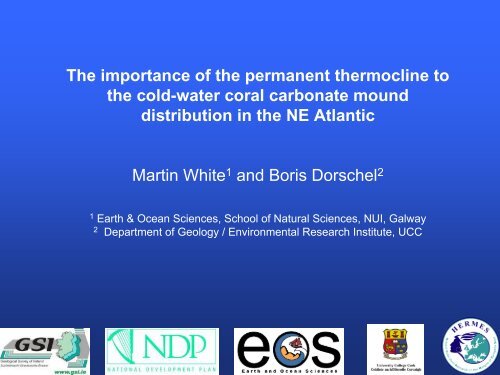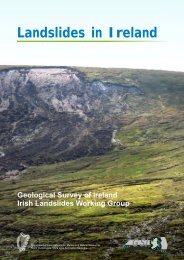The importance of the permanent thermocline to the cold-water coral ...
The importance of the permanent thermocline to the cold-water coral ...
The importance of the permanent thermocline to the cold-water coral ...
Create successful ePaper yourself
Turn your PDF publications into a flip-book with our unique Google optimized e-Paper software.
<strong>The</strong> <strong>importance</strong> <strong>of</strong> <strong>the</strong> <strong>permanent</strong> <strong>the</strong>rmocline <strong>to</strong><strong>the</strong> <strong>cold</strong>-<strong>water</strong> <strong>coral</strong> carbonate mounddistribution in <strong>the</strong> NE AtlanticMartin White 1 and Boris Dorschel 21Earth & Ocean Sciences, School <strong>of</strong> Natural Sciences, NUI, Galway2Department <strong>of</strong> Geology / Environmental Research Institute, UCC
Content:‣ Review <strong>of</strong> depth distribution <strong>of</strong> carbonate mounds‣ Define <strong>permanent</strong> <strong>the</strong>rmocline and associatedhydrography‣ Highlight <strong>importance</strong> <strong>of</strong> baroclinic motions associatedwith <strong>the</strong>rmoclineFrom: van Weering et al. (2003)
Carbonate mound on <strong>the</strong> Irish seabed• 1013 individual mounds• ~7 distinct mound provinces• 10s - 100s meter high• up <strong>to</strong> 5km base diameter• Mound provinces occur on <strong>the</strong>upper continental slopes
Depth distribution <strong>of</strong> carbonate mounds• Peak in mound abundancebetween 640-650 m• 94 % <strong>of</strong> mounds occurshallower than 1000 m bsl• 36 % between 600-700 m• skewed distribution with atail at greater depthsNumber <strong>of</strong> mound features detected withinINSS dataset:A) in 10 m depth intervals andB) in 100 m intervals as a % <strong>of</strong> <strong>to</strong>tal
Location <strong>of</strong> (left) Mounds and (right) long term observations <strong>of</strong> currents (.)and (x) example <strong>water</strong> column CTD pr<strong>of</strong>ile
<strong>The</strong> Permanent <strong>the</strong>rmoclineBase <strong>of</strong> <strong>the</strong> winter mixed layer: deepest extent <strong>of</strong> direct atmosphereRelatively sharp change in Temp hence Density between 600-1000 mWMLSeasonal<strong>the</strong>rmoclinePermanent<strong>the</strong>rmoclineFebOctDensityN = buoyancy freq.- Vertical density grad
Near seabed current strength• Mean vec<strong>to</strong>r speed (residual flow)at 8 - 50 mab• (8 m is assumed <strong>to</strong> be outside <strong>of</strong> mainfrictional bot<strong>to</strong>m layer)• All depths have a typical range 1-5 cms -1• Between 600-1000 m – residuals up <strong>to</strong>20 cm s -1• Highest residual flow speed oversteepest part <strong>of</strong> continental slopeResidual current speed (mean flow) vsdepth for ~40 locations in NE AtlanticO = individual obs; 100m mean
Internal or baroclinic motionsMIXEDWEAKSTRONGWEAKInternal oscillations <strong>of</strong> <strong>the</strong> density layers - can take two forms• Freely propagating internal waves• Longer period waves trapped <strong>to</strong> <strong>to</strong>pographic features, such as <strong>the</strong>continental slope. Long period – means greater than <strong>the</strong> inertial period(related <strong>to</strong> Coriolis frequency)Propagation characteristics depend on wave period, Coriolis force and N
K1 tide –amplitudeTrapped baroclinic waves: - diurnal tides• Diurnal tidal periods (24-25 hrs) longer than<strong>the</strong> local inertial period (2π/f) ~ 15 hrs• Tidal motion across margin may be rectified,amplified and trapped <strong>to</strong> <strong>the</strong> slope region• Amplification possibility is controlled by value<strong>of</strong> N and bot<strong>to</strong>m slope () and wave period.• Possible resonance at Nsin() = maximum• Resonance requires a matching <strong>of</strong> wave periodand natural period <strong>of</strong> <strong>water</strong> column• Nsin() is also <strong>the</strong> minimum wave period forresonance <strong>to</strong>p occur
Trapped Wave conditions at different carbonate mound locations25hrsNW PorcRockallHovlandNW PorcRockallHovlandMaximum ~ 850 m for alllocations except HovlandprovinceMinimum period < forcing period(24-25hrs) between 600-1200 m(except at Hovland province).<strong>The</strong>refore resonance may occur
Diurnal Tides are amplified at Belgica and Logachev (S Rockall Bank) moundsCurrents at Belgica moundsStrong tidal currents(> 50 cm/s) withdiurnal signal andspring-neap cycleDaily averagedcurrents show largealong slope residualswhich vary instrength on S-Ncycle‘rectification’ <strong>of</strong> <strong>the</strong>tideWhite et al, GML, 2007Diurnal amplification doesnot occur at Porcupine BankmoundsMis-match <strong>of</strong> N and pr<strong>of</strong>iles?Internal waves are importantat Porcupine Bank however.
Freely propagating internal wavesCgCpCpCgEnergy propagates at an angle depending on period and NGenerated or resonance where Enhanced energy where waves hitseabed where
Internal waves and N Porcupine BankResonance0 mSuspendedsediment conc.Energyenhanced500 mResonance1000 mRelationship between and • Resonance about 600 m. Evidencefor internal waves at that depth hasbeen observed• Energy enhancement 600-1200m1500 m2000 mStrongsuspendedsedimentsignal between500-600 m
Summary• Carbonate mounds found between 500-1000 m <strong>water</strong> depth• Depth range spans <strong>the</strong> upper end <strong>of</strong> <strong>the</strong> <strong>permanent</strong> <strong>the</strong>rmocline• <strong>The</strong> <strong>the</strong>rmocline (with steep margin slope) acts <strong>to</strong> focus wave energy &enhance periodic and residual current strengthResidual currentsShelf EdgeProductionxxEnhanced long-term, alongslopesediment fluxesActs <strong>to</strong> draw <strong>water</strong> in<strong>to</strong>bot<strong>to</strong>m layerWave motionsPermanent<strong>the</strong>rmoclinexIncreased currents andlarge cross-slope movement= large periodic fluxes <strong>of</strong>organic matter
















